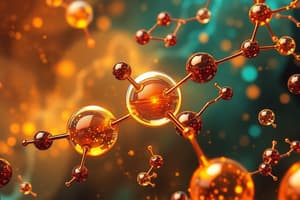Podcast
Questions and Answers
What determines the shape of an organic molecule?
What determines the shape of an organic molecule?
- The functional groups attached to the molecule
- The number of bonds in the molecule
- The length and arrangement of the carbon skeleton (correct)
- The type of atoms present in the molecule
Which of the following is NOT a way in which organic molecules can differ?
Which of the following is NOT a way in which organic molecules can differ?
- The combinations of attached atoms, called functional groups
- The length and arrangement of the carbon skeleton
- The kinds and location of atoms attached to the carbon skeleton
- The electronegativity of the atoms in the molecule (correct)
What is the purpose of functional groups in organic molecules?
What is the purpose of functional groups in organic molecules?
- To determine the shape of the molecule
- To control the reactivity of the molecule
- To determine the chemical nature of the molecule (correct)
- To provide structural support for the carbon skeleton
Which of the following is NOT considered a macromolecule of life?
Which of the following is NOT considered a macromolecule of life?
What is the relationship between isomers and empirical formulas?
What is the relationship between isomers and empirical formulas?
What is the unique property of a carbon atom that allows it to form long chains or rings?
What is the unique property of a carbon atom that allows it to form long chains or rings?
Which of the following is commonly found in organic molecules but not always present?
Which of the following is commonly found in organic molecules but not always present?
In which type of bond do two carbon atoms form double bonds between each other?
In which type of bond do two carbon atoms form double bonds between each other?
Which factor determines the properties of organic molecules along with the types of atoms present?
Which factor determines the properties of organic molecules along with the types of atoms present?
What is the complex organic molecule represented by HC ≡ N?
What is the complex organic molecule represented by HC ≡ N?
How many separate, single covalent bonds are carbon atoms usually involved in?
How many separate, single covalent bonds are carbon atoms usually involved in?
What is the defining characteristic of organic compounds?
What is the defining characteristic of organic compounds?
What is the term used to describe the backbone or framework of an organic molecule?
What is the term used to describe the backbone or framework of an organic molecule?
Which of the following is an example of a functional group in organic molecules?
Which of the following is an example of a functional group in organic molecules?
What is the significance of functional groups in organic molecules?
What is the significance of functional groups in organic molecules?
Which of the following is an example of a macromolecule found in living systems?
Which of the following is an example of a macromolecule found in living systems?
What is the relationship between the terms 'organic,' 'organism,' 'organ,' and 'organize'?
What is the relationship between the terms 'organic,' 'organism,' 'organ,' and 'organize'?
Flashcards are hidden until you start studying




